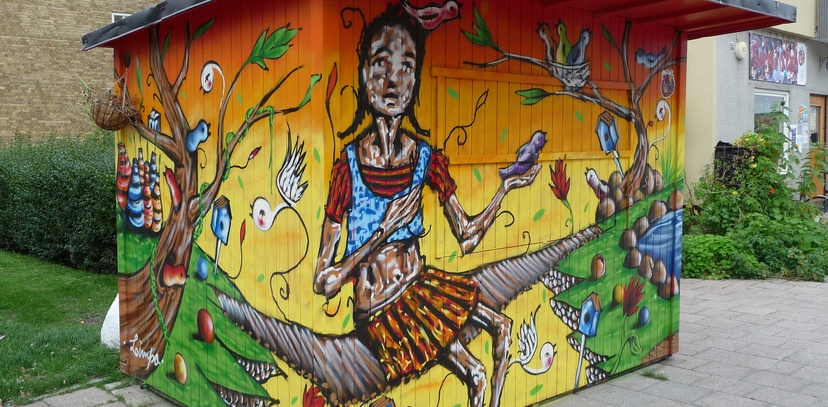
Read our guest post by Nina Mguni, co-author of Rowing Against the Tide, published today by the Young Foundation.
It was late in the evening as we ascended the steep slopes of Les Roquetes. With its winding streets, outdoor escalators and hilltop views, this Barcelona neighbourhood resembled a favela. We arrived at our destination, a little community hall, and were met by several members of the local neighbourhood committee. They were a feisty bunch, talking at extreme speed in Spanish, listing their trials and tribulations of antagonising, cajoling and enticing local state agencies and residents.
We were there to ask the question: "what is community resilience?" Had we stumbled upon it here? And if so, and we wanted to bottle it, what would be the key ingredients? What was clear is that the group of residents we met (who varied in age and gender but were predominantly women) invested much time and energy in creating a cohesive neighbourhood by building a strong network of community organisations and social services helping their neighbours. Faced with a plethora of social challenges, their response to emerging tensions or problems was often immediate and collective.
One story we heard about was a local fight between two men that inflamed racial tensions. Some locals reacted to the incident and the following day 300 people gathered in the neighbourhood calling on residents to "kill all the immigrants!" Working together, many community organisations immediately went out to talk with the crowd and quickly initiated a number of community activities, such as a carnival, the creation of a beautiful display of images that represented the diversity of residents, and sharing soup recipes, all to calm tensions. As one resident told us, "very serious and difficult incidents have happened, and we always say that we managed to deal with this by working all together."
Resilience is a term that is increasingly used in the policy sphere. There is much appeal in embracing a term which suggests the creation of self-sustaining community activities that help residents withstand shocks, be they economic, social or environmental. With the long shadow of the recession still over us, and with it reduced public services, a concept that orientates the emphasis (and the cost) away from public service delivery and towards something more community-led has much appeal to policy makers. This can imply the illusory but suggestive idea that resilient communities are less reliant on state provision, with the view that communities will respond and be creative and entrepreneurial in interpreting and acting on the challenges that surface.
In our new think piece, Rowing against the tide, we ask what is the role of the state, to get out of the way or to manage community response? Here we argue that the notion that community resilience requires little or no state intervention is an illusion. Earlier that same day, we had sat in the local archives office where we heard how in the 1960s, the newly arrived residents from the south of Spain had worked on Sundays to build the neighbourhood's housing and infrastructure. But having built their own homes and sewers they then had to fight for services, to the point of hijacking local buses, to ensure that local transport routes catered for residents in the area. A relationship between the residents and local agencies had to be brokered.
What is apparent is that individuals and networked groups of residents do self activate, with little support from local agencies, and are central to community resilient responses. In Roquetes the role of particularly dynamic and resilient individuals was evident. These individuals did not simply resign themselves to the poor reputation of their community, choosing instead to hold their communities to a higher ideal. But people get tired, they lose interest, and they move on. Initiatives that are started by motivated individuals need to be sustained and sustainable.
This hints at the role for state agencies. Individual residents were sustained by platforms which enabled and supported them to act. Strong social networks existed, which allowed access to people and places. They were organic, emerging from tangible and intangible alliances, as well as through support from local agencies. Local initiatives and interventions which promote social networks, or are peer supported, such as community gardening or peer supported discussion groups, help neighbours to reach out to each other, and use the skills and experiences from within communities.
There is also a need to make informality credible and durable. What can, at first glance, be episodic and anarchic should be made visible to local commissioners and local agencies. Approaches like ethnography and observation will help surface what can be invisible to traditional data collection tools.
This snapshot suggests that the key ingredients of community resilience are, in part, formed of a fine blend of enterprising and passionate individuals who harness local networks to access resources to enhance the protective factors of their local community. But nurturing the adaptive capacity of the community needs an equally adaptive local state. A relationship between local state agencies and residents that welcomes what can appear to be 'messy' yet provides community spaces, resources or small sums of money, will support community resilience. During our evening with the residents of Roquetes, in that little community hall, sitting amongst the group was an official from the city council. It was not always a comfortable discussion but he was still a participant at the table.
This post was originally written by Nina Mguni for the Young Foundation.